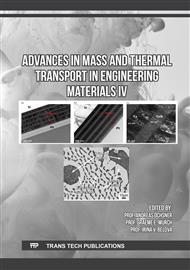[1]
J. Chengzao, M. Zheng, Y. J. P. E. Zhang, and Development, "Unconventional hydrocarbon resources in China and the prospect of exploration and development," vol. 39, no. 2, pp.139-146, 2012.
DOI: 10.1016/s1876-3804(12)60026-3
Google Scholar
[2]
I. Capellán-Pérez, M. Mediavilla, C. de Castro, Ó. Carpintero, and L. J. J. E. Miguel, "Fossil fuel depletion and socio-economic scenarios: An integrated approach," vol. 77, pp.641-666, 2014.
DOI: 10.1016/j.energy.2014.09.063
Google Scholar
[3]
T. Zhou, H. Yuan, F. Xu, and R. J. E. Wu, "Tight Sandstone Reservoir Characteristics and Controlling Factors: Outcrops of the Shanxi Formation, Liujiang River Basin, North China," vol. 16, no. 10, p.4127, 2023.
DOI: 10.3390/en16104127
Google Scholar
[4]
M. M. A. Ahfaf, C. A. Ali, H. Jamil, E. J. J. J. o. P. S. Adepehin, and Engineering, "Pore modification mechanisms in a deeply buried non-marine sandstone: The Early Cretaceous Upper Sarir Sandstone Formation, Sirte Basin, Libya," vol. 205, p.108813, 2021.
DOI: 10.1016/j.petrol.2021.108813
Google Scholar
[5]
H. Yin, J. Zhao, G. Tang, L. Zhao, X. Ma, and S. Wang, "Pressure and fluid effect on frequency‐dependent elastic moduli in fully saturated tight sandstone," Journal of Geophysical Research: Solid Earth, vol. 122, no. 11, pp.8925-8942, 2017.
DOI: 10.1002/2017jb014244
Google Scholar
[6]
A. Agi, R. Junin, and A. J. I. N. L. Gbadamosi, "Mechanism governing nanoparticle flow behaviour in porous media: insight for enhanced oil recovery applications," vol. 8, pp.49-77, 2018.
DOI: 10.1007/s40089-018-0237-3
Google Scholar
[7]
C. Chao, G. Xu, and X. J. C. E. S. Fan, "Effect of surface tension, viscosity, pore geometry and pore contact angle on effective pore throat," vol. 197, pp.269-279, 2019.
DOI: 10.1016/j.ces.2018.12.029
Google Scholar
[8]
A. Namaee-Ghasemi, S. Ayatollahi, and H. J. S. J. Mahani, "Pore-scale simulation of the interplay between wettability, capillary number, and salt dispersion on the efficiency of oil mobilization by low-salinity waterflooding," vol. 26, no. 06, pp.4000-4021, 2021.
DOI: 10.2118/206728-pa
Google Scholar
[9]
M. M. Selim, S. El-Safty, A. Tounsi, and M. J. A. E. J. Shenashen, "Review of the impact of the external magnetic field on the characteristics of magnetic nanofluids," vol. 76, pp.75-89, 2023.
DOI: 10.1016/j.aej.2023.06.018
Google Scholar
[10]
A. Katiyar, P. Dhar, T. Nandi, S. K. J. E. T. Das, and F. Science, "Enhanced heat conduction characteristics of Fe, Ni and Co nanofluids influenced by magnetic field," vol. 78, pp.345-353, 2016.
DOI: 10.1016/j.expthermflusci.2016.06.014
Google Scholar
[11]
P. Samyn, A. Barhoum, T. Öhlund, and A. J. J. o. M. S. Dufresne, "Nanoparticles and nanostructured materials in papermaking," vol. 53, pp.146-184, 2018.
DOI: 10.1007/s10853-017-1525-4
Google Scholar
[12]
C. J. Chirayil, J. Abraham, R. K. Mishra, S. C. George, and S. Thomas, "Instrumental techniques for the characterization of nanoparticles," in Thermal and rheological measurement techniques for nanomaterials characterization: Elsevier, 2017, pp.1-36.
DOI: 10.1016/b978-0-323-46139-9.00001-3
Google Scholar
[13]
O. Karakoc et al., "Smart and state-of-the-art materials in oil and gas industry," in Sustainable materials for transitional and alternative energy: Elsevier, 2021, pp.1-51.
DOI: 10.1016/b978-0-12-824379-4.00005-7
Google Scholar
[14]
S. Sikiru, N. Yahya, and H. Soleimani, "Photon–phonon interaction of surface ionic adsorption within electric double layer in reservoir sandstone," Journal of materials research and technology, vol. 9, no. 5, pp.10957-10969, 2020.
DOI: 10.1016/j.jmrt.2020.07.095
Google Scholar
[15]
S. Sikiru, N. Yahya, H. Soleimani, A. M. Ali, and Y. Afeez, "Impact of ionic-electromagnetic field interaction on Maxwell-Wagner polarization in porous medium," Journal of Molecular Liquids, vol. 318, p.114039, 2020.
DOI: 10.1016/j.molliq.2020.114039
Google Scholar
[16]
V. Nalladega, S. Sathish, T. Murray, E. Shin, K. V. Jata, and M. Blodgett, "Experimental investigation of interaction of very low frequency electromagnetic waves with metallic nanostructure," Journal of Applied Physics, vol. 109, no. 11, p.114907, 2011.
DOI: 10.1063/1.3587238
Google Scholar
[17]
G. J. A. Verhoeven, "The reflection of two fields: electromagnetic radiation and its role in (aerial) imaging," vol. 55, pp.13-18, 2017.
Google Scholar
[18]
D. Maity, S. Kale, R. Kaul-Ghanekar, J.-M. Xue, J. J. J. o. M. Ding, and m. Materials, "Studies of magnetite nanoparticles synthesized by thermal decomposition of iron (III) acetylacetonate in tri (ethylene glycol)," vol. 321, no. 19, pp.3093-3098, 2009.
DOI: 10.1016/j.jmmm.2009.05.020
Google Scholar
[19]
U. K. Sur et al., "Synthesis and characterization of stable aqueous dispersions of graphene," vol. 39, no. 1, pp.159-165, 2016.
Google Scholar
[20]
M. Zargartalebi, R. Kharrat, and N. J. F. Barati, "Enhancement of surfactant flooding performance by the use of silica nanoparticles," vol. 143, pp.21-27, 2015.
DOI: 10.1016/j.fuel.2014.11.040
Google Scholar
[21]
K. Winkler et al., "Ionic strength-controlled deposition of charged nanoparticles on a solid substrate," vol. 115, no. 39, pp.19096-19103, 2011.
DOI: 10.1021/jp206704s
Google Scholar
[22]
S. Sikiru, H. Soleimani, A. Shafie, and G. Kozlowski, "Simulation and experimental investigation of dielectric and magnetic nanofluids in reduction of oil viscosity in reservoir sandstone," Journal of Petroleum Science and Engineering, vol. 209, p.109828, 2022.
DOI: 10.1016/j.petrol.2021.109828
Google Scholar


